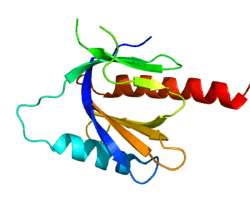Amyloid beta A4 precursor protein-binding family B member 3 is a protein that in humans is encoded by the APBB3 gene.[4][5]
The protein encoded by this gene is a member of the APBB protein family. It is found in the cytoplasm and binds to the intracellular domain of the Alzheimer's disease beta-amyloid precursor protein (APP) as well as to other APP-like proteins. It is thought that the protein encoded by this gene may modulate the internalization of APP. Multiple transcript variants encoding several different isoforms have been found for this gene.[5]
References
- 1 2 3 GRCh38: Ensembl release 89: ENSG00000113108 - Ensembl, May 2017
- ↑ "Human PubMed Reference:".
- ↑ "Mouse PubMed Reference:".
- ↑ Ermekova KS, Zambrano N, Linn H, Minopoli G, Gertler F, Russo T, Sudol M (Jan 1998). "The WW domain of neural protein FE65 interacts with proline-rich motifs in Mena, the mammalian homolog of Drosophila enabled". J Biol Chem. 272 (52): 32869–77. doi:10.1074/jbc.272.52.32869. PMID 9407065.
- 1 2 "Entrez Gene: APBB3 amyloid beta (A4) precursor protein-binding, family B, member 3".
Further reading
- Tanahashi H, Tabira T (1999). "Molecular cloning of human Fe65L2 and its interaction with the Alzheimer's beta-amyloid precursor protein". Neurosci. Lett. 261 (3): 143–6. doi:10.1016/S0304-3940(98)00995-1. PMID 10081969.
- Tanahashi H, Tabira T (1999). "Genome structure and chromosomal mapping of the gene for Fe65L2 interacting with Alzheimer's beta-amyloid precursor protein". Biochem. Biophys. Res. Commun. 258 (2): 385–9. doi:10.1006/bbrc.1999.0639. PMID 10329396.
- Tanahashi H, Tabira T (2002). "Characterization of an amyloid precursor protein-binding protein Fe65L2 and its novel isoforms lacking phosphotyrosine-interaction domains". Biochem. J. 367 (Pt 3): 687–95. doi:10.1042/BJ20020562. PMC 1222940. PMID 12153398.
- Strausberg RL, Feingold EA, Grouse LH, et al. (2003). "Generation and initial analysis of more than 15,000 full-length human and mouse cDNA sequences". Proc. Natl. Acad. Sci. U.S.A. 99 (26): 16899–903. doi:10.1073/pnas.242603899. PMC 139241. PMID 12477932.
- Chang Y, Tesco G, Jeong WJ, et al. (2004). "Generation of the beta-amyloid peptide and the amyloid precursor protein C-terminal fragment gamma are potentiated by FE65L1". J. Biol. Chem. 278 (51): 51100–7. doi:10.1074/jbc.M309561200. PMID 14527950.
- Ota T, Suzuki Y, Nishikawa T, et al. (2004). "Complete sequencing and characterization of 21,243 full-length human cDNAs". Nat. Genet. 36 (1): 40–5. doi:10.1038/ng1285. PMID 14702039.
- Gerhard DS, Wagner L, Feingold EA, et al. (2004). "The status, quality, and expansion of the NIH full-length cDNA project: the Mammalian Gene Collection (MGC)". Genome Res. 14 (10B): 2121–7. doi:10.1101/gr.2596504. PMC 528928. PMID 15489334.
- Rual JF, Venkatesan K, Hao T, et al. (2005). "Towards a proteome-scale map of the human protein-protein interaction network". Nature. 437 (7062): 1173–8. doi:10.1038/nature04209. PMID 16189514.


